Spring Boot——开发热部署及常用工具
本文共 1054 字,大约阅读时间需要 3 分钟。
Spring Boot——开发热部署及常用工具
一、热部署
在开发中我们修改一个Java文件后往往需要重启应用,这导致花费了大量的时间,我们希望在不重启应用的情况下,程序可以自动部署(热部署)。实现热部署,有以下四种情况:
1、模板引擎
- 在Spring Boot中开发情况下禁用模板引擎的缓存cache
spring.thymeleaf.cache=false
- 页面模板改变ctrl+F9可以重新编译当前页面并生效
2、Spring Boot Devtools
(1)引入依赖
org.springframework.boot spring-boot-devtools
(2)IDEA使用ctrl+F9
- 在没有引入Devtools时,使用ctrl+F9重新编译,只能使编译的文件发生变化,但是并不能影响正在运行的工程。
- 引入Devtools后,使用ctrl+F9重新编译,当前运行的工程也会受到影响。
注意:
Intellij IEDA和Eclipse不同,Eclipse设置了自动编译之后,修改类它会自动编译,而IDEA在非RUN或DEBUG情况下才会自动编译(前提是你已经设置了Auto-Compile)。- 设置自动编译(settings-compiler-make project automatically)
- ctrl+shift+alt+/(maintenance)
- 勾选compiler.automake.allow.when.app.running
设置 IDEA 的⾃动编译;

设置 IDEA 运⾏⾃动运⾏
快捷键:Shift+Ctrl+Alt+/ 进入Registry,勾选 compiler.automake.allow.when.app.running
二、RestfulToolkit
- 可以看到项⽬中所有的 Restful 接⼝,也就是所有使⽤了@RequestMapping 的⽅法,只要使⽤了此注解的⽅法,都可以被⽤户直接调⽤到。
- 可以模拟(HTTP)请求,这样连 Postman都可以省了。
在plugin中在线安装RestfulToolkit后重启Idea.

三、Save Actions——格式化
Save Actions插件主要用来自动对齐、自动导包、自动括号补全;
在plugins中加载Save Actions插件,后进行重启,
安装完后,需要在settions中配置 Save Actions:

转载地址:http://zjnwz.baihongyu.com/
你可能感兴趣的文章
no such file or directory AndroidManifest.xml
查看>>
No toolchains found in the NDK toolchains folder for ABI with prefix: mips64el-linux-android
查看>>
NO.23 ZenTaoPHP目录结构
查看>>
no1
查看>>
NO32 网络层次及OSI7层模型--TCP三次握手四次断开--子网划分
查看>>
NOAA(美国海洋和大气管理局)气象数据获取与POI点数据获取
查看>>
NoClassDefFoundError: org/springframework/boot/context/properties/ConfigurationBeanFactoryMetadata
查看>>
node
查看>>
node exporter完整版
查看>>
node HelloWorld入门篇
查看>>
Node JS: < 一> 初识Node JS
查看>>
Node JS: < 二> Node JS例子解析
查看>>
Node Sass does not yet support your current environment: Linux 64-bit with Unsupported runtime(93)解决
查看>>
Node Sass does not yet support your current environment: Windows 64-bit with Unsupported runtime(72)
查看>>
Node 裁切图片的方法
查看>>
node+express+mysql 实现登陆注册
查看>>
Node+Express连接mysql实现增删改查
查看>>
node, nvm, npm,pnpm,以前简单的前端环境为什么越来越复杂
查看>>
Node-RED中Button按钮组件和TextInput文字输入组件的使用
查看>>
vue3+Ts 项目打包时报错 ‘reactive‘is declared but its value is never read.及解决方法
查看>>